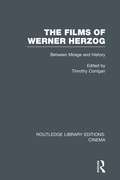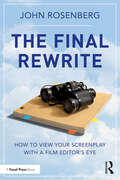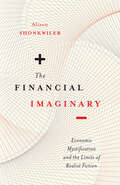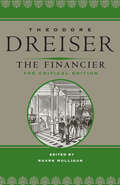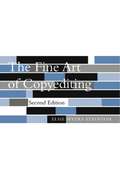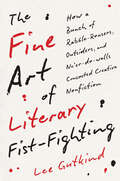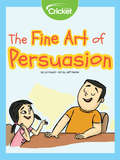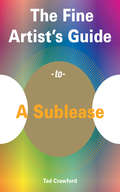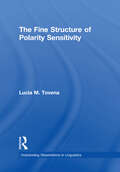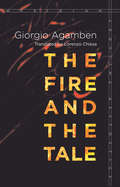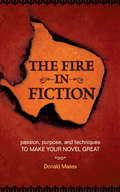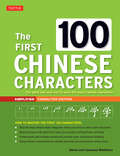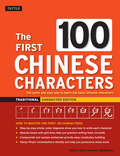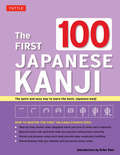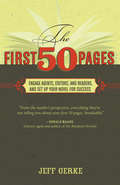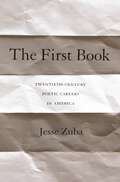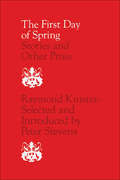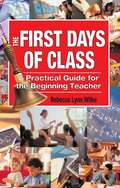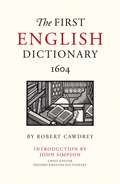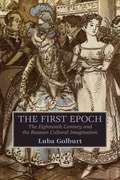- Table View
- List View
The Films of Werner Herzog: Between Mirage and History (Routledge Library Editions: Cinema)
by Timothy CorriganGiven Herzog’s own pronouncement that ‘film is not the art of scholars, but of illiterates,’ it is not surprising that his work has aroused ambivalent and contradictory responses. Visually and philosophically ambitious and at the same time provocatively eccentric, Herzog’s films have been greeted equally by extreme adulation and extreme condemnation. Even as Herzog’s rebellious images have gained him a reputation as a master of the German New Wave, he has been attacked for indulging in a romantic naiveté and wilful self-absorption. To his hardest critics, Herzog’s films appear as little more than Hollywood fantasies disguised as high seriousness. This book is an attempt to illuminate these contradictions. It gathers essays that focus from a variety of angles on Herzog and his work. The contributors move beyond the myths of Herzog to investigate the merits of his work and its place in film history. A challenging range of films is covered, from Fata Morgana and Aguirre, the Wrath of God to more recent features such as Nosferatu and Where the Green Ants Dream, offering the reader ways of understanding why, whatever the controversies surrounding Herzog and his films, he remains a major and popular international filmmaker. Orignally published in 1986.
The Final Cut (House of Cards #3)
by Michael DobbsThe final book in the Internationally Bestselling trilogy that inspired the hit Netflix series House of Cards.Months from taking his place as the longest-serving Prime Minister this century, Francis Urquhart's country is tiring of him. But he's not about to be driven from office. If the public demands new blood, that is precisely what he will give them...This is a different Francis Urquhart – more vulnerable, more loving, and more ruthless than ever. He will risk everything, but one thing is certain: whatever the outcome of this, his greatest gamble, the name of Francis Urquhart will never be forgotten.Finishing the dark tale of greed, corruption, and unquenchable ambition, The Final Cut reveals that no matter the country, politics, intrigue and passion reign in the corridors of power. An explosive political thriller, fans of Vince Flynn, David Baldacci and Robert Ludlum will enjoy this stunning conclusion to Dobb's trilogy.As a former advisor to Margaret Thatcher, Conservative Party Chief of Staff, and now peer of the realm and Conservative member of the House of Lords, Baron Michael Dobbs provides an insider look at the twists and turns of British politics.Other books in the House of Cards series:House of Cards, Book 1 – The dark, twisting schemes of a politician determined to succeedTo Play The King, Book 2 – Newly elected Prime Minister plots to take on the Monarchy to grab even more powerThe Final Cut, Book 3 – The perfect finale to this twisted trilogy, Urquhart refuses to close his career quietlyWhat readers are saying about House of Cards:"If you enjoy political intrigue, murder, and a truly loathsome character you will greatly enjoy this final installment by Dobbs.""Great book highly recommend if you are currently viewing House of Cards.""Francis Urquhart is on a par with RIchard III as a baddie of literature. And yet Dobbs has us cheering from him at every turn.""Dobbs ties off the House of Cards series with a bang and pens, perhaps, his best novel of the trilogy.""Francis Urquhart at his finest, the ultimate chess game against the world.""the sharpest, smartest, and most intelligent writing I have read.""A superb ending to the series!"What reviewers are saying about House of Cards:"A triumphant return...the best book of the three. The action is unflagging, the characterization razor-sharp, the satirical barbs at politics and politicians unfailingly accurate. What a brilliant creation F.U. is." —Sunday Telegraph"Razor-sharp and merciless...One thing is certain: F.U. will be remembered for much longer than many a real Prime Minister." - Daily Mail"Thoroughly entertaining. Urquhart is a joy, and the wonderful games he plays have lost none of their attraction." - The TimesWhat everyone is saying about the House of Cards books:"This blood and thunder tale, lifelike and thoroughly cynical, certainly carries the ring of authenticity....a great triumph." — The Independent"…a political thriller writer with a marvellous inside track knowledge of government." - Daily Express"If you are a fan of the modern TV series than you should definitely pick up these books.""Michael Dobbs has an uncanny knack of forecasting the future. A fascinating read and a conclusion that would send a chill through Buckingham Palace." - Sunday Express
The Final Rewrite: How to View Your Screenplay with a Film Editor’s Eye
by John RosenbergThis book offers a unique perspective on crafting your screenplay from an editor’s point-of-view. Special features include before and after examples from preproduction scripts to post production final cuts, giving screenwriters an opportunity to understand how their screenplay is visualized in post production. By the time a script reaches the editing room, it has passed through many hands and undergone many changes. The producer, production designer, director, cinematographer, and actor have all influenced the process before it gets to the editor’s hands. Few scripts can withstand the careful scrutiny of the editing room. This book reveals how to develop a script that will retain its original vision and intent under the harsh light of the editing console. It provides insights that writers (as well as producers and directors) need and editors can provide for a safe journey from the printed page to the final release. This book is ideal for aspiring and early career screenwriters, as well as filmmakers and established screenwriters who want to gain a better understanding of the editing process.
The Financial Image: Finance, Philosophy and Contemporary Film (Palgrave Studies in Literature, Culture and Economics)
by Alasdair KingThe Financial Image: Finance, Philosophy, and Contemporary Film draws on a broad range of narrative feature films, documentaries, and moving image installations in the US, Europe, and Asia. Using frameworks from contemporary philosophy and critical finance studies, the book explores how contemporary cinema has registered recent financial and economic issues. The book focuses on how filmmakers have found formal means to explore, celebrate, and critique the increasingly important role that the financial sector plays in shaping global economic, political, ethical, and social life.
The Financial Imaginary: Economic Mystification and the Limits of Realist Fiction
by Alison ShonkwilerAs the world has been reshaped since the 1970s by neoliberalism and globalization, increasing financial abstraction has presented a new political urgency for contemporary writers. Globalized finance, the return to Gilded Age levels of inequality, and the emergence of new technologies pose a similar challenge to the one faced by American social realists a century ago: making the virtualization of capitalism legible within the conventions of the realist novel. In The Financial Imaginary, Alison Shonkwiler reads texts by Richard Powers, Don DeLillo, Jane Smiley, Teddy Wayne, and Mohsin Hamid to examine how fiction confronts the formal and representational mystifications of the economic. As Shonkwiler shows, these contemporary writers navigate the social, moral, and class preoccupations of American &“economic fiction&” (as shaped by such writers as William Dean Howells, Henry James, Frank Norris, and Theodore Dreiser), even as they probe the novel&’s inadequacies to tell the story of an increasingly abstract world system. Drawing a connection from historical and theoretical accounts of financialization to the formal contours of contemporary fiction, The Financial Imaginary examines the persistent yet vexed relationship between financial representation and the demands of literary realism. It argues that the novel is essential to understanding our relation to the mystifications of abstraction past and present.
The Financier: The Critical Edition (The Dreiser Edition)
by Theodore DreiserFirst published in 1912, Theodore Dreiser's third novel, The Financier, captures the ruthlessness and sparkle of the Gilded Age alongside the charismatic amorality of the power brokers and bankers of the mid-nineteenth century. This volume is the first modern edition of The Financier to draw on the uncorrected page proofs of the original 1912 version, which established Dreiser as a master of the American business novel. The novel was the first volume of Dreiser’s Trilogy of Desire, also known as the Cowperwood Trilogy, which includes The Titan (1914) and The Stoic (1947). Dreiser laboriously researched the business practices and personal exploits of real-life robber baron Charles Yerkes to narrate Frank Algernon Cowperwood's early career in The Financier, which explores the unscrupulous world of finance from the Civil War through the panic incited by the 1871 Chicago fire. In 1927, the monumental novel reappeared in a radically revised version for which Dreiser, notorious for lengthy novels, agreed to cut more than two hundred and seventy pages. This revised version became the most familiar, reprinted by publishers and studied by scholars for decades. For this new edition, Roark Mulligan meticulously reviewed earlier versions of the novel and its publication history, including the last-minute removal of paragraphs, pages, and even whole chapters from the 1912 edition, cuts based mainly on the advice of H. L. Mencken. The restored text better matches Dreiser's original vision for the work. More than three hundred additional pages not available to modern readers--including those cut from the 1927 edition and more than seventy hastily removed from the manuscript just days before publication in 1912--more effectively establish characterization and motivation. Restored passages dedicated to the internal thoughts of major and minor characters bring a softer dimension to a novel primarily celebrated for its realistic attention to the cold external world of finance. Mulligan's historical commentary reveals new insights into Dreiser's creative practices and how his business knowledge shaped The Financier. This supplemental material considers the novel's place within the tradition of American business novels and its reflections on the scandalous business practices of the robber baron era.
The Fine Art of Copyediting (2nd Edition)
by Elsie Myers StaintonIncludes Advice To Editors On How To Get Along With Authors, And Tips On Style For Both.
The Fine Art of Copyediting: Including Advice To Editors On How To Get Along With Authors, And Tips On Style For Both
by Elsie Myers StaintonMany stylebooks and manuals explain writing, but before the release ten years ago of Elsie Myers Stainton's The Fine Art of Copyediting, few addressed the practices and problems of editing. This handbook has guided users through the editing process for books and journals, with tips on how to be diplomatic when recommending changes, how to edit notes and bibliographies, how to check proofs, and how to negotiate the ethical, intellectual, and emotional problems characteristic of the editorial profession. Now featuring solid advice on computer editing and a new chapter on style, as well as more information on references, bibliographies, indexing, and bias-free writing, The Fine Art of Copyediting, Second Edition offers the same wealth of information that prompted William Safire to commend the first edition in The New York Times Magazine.Complete with helpful checklists for the manuscript, proof, and index stages of book production, as well as an excellent bibliography of reference works useful to the copyeditor, The Fine Art of Copyediting, Second Edition is an indispensable desk reference for writers and editors confronting a host of questions each day. Why use the word "people" instead of "persons?" What precautions are necessary for publishers to avoid libel suits? How can an editor win an author's trust? What type fonts facilitate the copyediting process? How does computer editing work? For experienced and novice copyeditors, writers and students, this is the source for detailed, step-by-step guidance to the entire editorial process.
The Fine Art of Literary Fist-Fighting: How a Bunch of Rabble-Rousers, Outsiders, and Ne'er-do-wells Concocted Creative Nonfiction
by Lee GutkindAn account of the emergence of creative nonfiction, written by the &“godfather&” of the genre In the 1970s, Lee Gutkind, a leather-clad hippie motorcyclist and former public relations writer, fought his way into the academy. Then he took on his colleagues. His goal: to make creative nonfiction an accepted academic discipline, one as vital as poetry, drama, and fiction. In this book Gutkind tells the true story of how creative nonfiction became a leading genre for both readers and writers. Creative nonfiction—true stories enriched by relevant ideas, insights, and intimacies—offered liberation to writers, allowing them to push their work in freewheeling directions. The genre also opened doors to outsiders—doctors, lawyers, construction workers—who felt they had stories to tell about their lives and experiences. Gutkind documents the evolution of the genre, discussing the lives and work of such practitioners as Joan Didion, Tom Wolfe, Norman Mailer, James Baldwin, Zora Neale Hurston, Rachel Carson, Upton Sinclair, Janet Malcolm, and Vivian Gornick. Gutkind also highlights the ethics of writing creative nonfiction, including how writers handle the distinctions between fact and fiction. Gutkind&’s book narrates the story not just of a genre but of the person who brought it to the forefront of the literary and journalistic world.
The Fine Art of Persuasion
by Liz HuyckDo you ever have trouble getting someone to agree with you on something? Reaching your goals can sometimes be hard if someone doesn't see eye-to-eye with you! Learn some tips to improve your persuasion skills as you follow along with two children as they try to convince their parents to get a family pet.
The Fine Artist's Guide to A Sublease
by Tad CrawfordPart of The Fine Artist's Guide series, this classic guide provides information about issues relevant to artists today. It explores several tactics for negotiating a beneficial sublease, how to reduce studio overhead through subletting, and the process of drafting a sublease. This guide demonstrates three types of leases (Form 20, 21, 22) and their provisions, includes a sample sublease contract, and contains helpful negotiation checklists.
The Fine Structure of Polarity Sensitivity (Outstanding Dissertations in Linguistics)
by Lucia M. TovenaFirst Published in 1998. Part of the Outstanding Dissertations in Linguistics series, this study investigates the phenomenon of polarity sensitivity. It proposes a new perspective which focuses on the behaviour and properties of sensitive items and the phrases they form. It originated in the observation that the fine structure of the phenomenon requires a more articulated analysis than the standard one based on licensing conditions.
The Fire and the Tale
by Giorgio Agamben Lorenzo ChiesaWhat is at stake in literature? Can we identify the fire that our stories have lost, but that they strive, at all costs, to rediscover? And what is the philosopher's stone that writers, with the passion of alchemists, struggle to forge in their word furnaces? For Giorgio Agamben, who suggests that the parable is the secret model of all narrative, every act of creation tenaciously resists creation, thereby giving each work its strength and grace. The ten essays brought together here cover works by figures ranging from Aristotle to Paul Klee and illustrate what urgently drives Agamben's current research. As is often the case with his writings, their especial focus is the mystery of literature, of reading and writing, and of language as a laboratory for conceiving an ethico-political perspective that places us beyond sovereign power.
The Fire in Fiction: Passion, Purpose and Techniques to Make Your Novel Great
by Donald MaassMaass, a literary agent and author of other books on novel writing, explains how novelists can instill their stories with passion and keep the reader excited and engaged. He contends that passion is a practical tool that can be drawn on at any time and shows how the day-to-day story development of a novel is key. He provides examples of strong characters, settings, voice, and conflict in published novels, and how to make the impossible feel real and write hyperreality, with exercises for working on writing techniques. There is no bibliography. Annotation ©2009 Book News, Inc. , Portland, OR (booknews. com)
The First 100 Chinese Characters: Simplified Character Edition
by Alison Matthews Laurence MatthewsThis book is a quick and easy way to learn basic Chinese Characters.All beginning students of Chinese struggle to memorize and learn to write the Chinese characters. The First 100 Chinese Characters adopts a structural approach which helps students to quickly master the basic characters that are fundamental to this language.The English meanings, pronunciations in hanyu pinyin and alternate forms (if any) for each Chinese character are presented along with a stroke order guide and spaces for writing practice. Printed with gray guidelines, the stroke order guides are designed to be traced over to teach students the standard sequence of strokes used to write the character. Related compounds and phrases are given to assist in vocabulary building. Three indexes at the back allow the characters to be looked-up by their English meanings, hanyu pinyin pronunciations, or radicals. Extra practice sheets are also provided.This book contains: Step-by-step stroke order diagrams show you how to write each character. Special boxes with grid lines help you practice writing them correctly. Compounds and sample sentences provide easy vocabulary building. Hanyu pinyin romanizations identify and help you pronounce every word.
The First 100 Chinese Characters: Traditional Character Edition
by Alison Matthews Laurence MatthewsThis book is a quick and easy way to learn the first 100 basic Chinese traditional characters.For effective leaning, memorization and practice, each Chinese character is shown separately on a single page, together with its English definitions, hanyu pinyin romanization, alternate form (if any), a stroke order guide and ample space for writing practice. Printed in gray lines, the stroke order guides introduce the student to the standard stroke sequence used in writing the characters, by tracing over them. After learning the correct stroke order, the student can then practice writing the character on their own, thus reinforcing recognition and memorization. Large boxes with grids for correct proportions are provided. Related compounds and phrases containing each character are also included to assist in vocabulary building. Three indexes (alphabetically by the English meanings and the pinyin romanization, and by radicals) are provided at the back of the book for quick and esy reference, along with extra sheets of blank boxes for writing practice. Featured are:The 100 most frequently-used Chinese charactersFoundation characters for the HSK A level language proficiency testStandard hanyu pinyin romanizationsStep-by-step stroke order guides and ample space for writing practiceOver 500 words and phrases containing the basic charactersConcise English definitions
The First 100 Japanese Kanji
by Eriko SatoThis is an invaluable study guide for learning basic Japanese characters.The first 100 Japanese Kanji is intended for beginning students, or experienced speakers who need to practice their written Japanese. Kanji are an essential part of the Japanese language and together with kana (hiragana and katakana) comprise the written component of Japanese.This book presents the kanji characters that are most commonly used. They have been carefully selected for rapid and effective learning. Each kanji's readings, meanings, and common compounds are presented, and romanized pronunciations for English speakers (romanji) are included as well. Printed with gray guidelines, stroke order guides are designed to be traced over to teach students the standard sequence of strokes used to write each character. Three indexes at the back allow the characters to be looked up as with a dictionary or by their readings. Students who wish to practice writing kanji will find extra practice sheets available.This book includes:Step-by-step stroke order diagrams for each characterSpecial boxes with grid lines to practice writing charactersWords and phrases using each kanjiRomanizations (romanji) to help identify and pronounce every word
The First 100 Japanese Kanji
by Eriko SatoThis is an invaluable study guide for learning basic Japanese characters.The first 100 Japanese Kanji is intended for beginning students, or experienced speakers who need to practice their written Japanese. Kanji are an essential part of the Japanese language and together with kana (hiragana and katakana) comprise the written component of Japanese.This book presents the kanji characters that are most commonly used. They have been carefully selected for rapid and effective learning. Each kanji's readings, meanings, and common compounds are presented, and romanized pronunciations for English speakers (romanji) are included as well. Printed with gray guidelines, stroke order guides are designed to be traced over to teach students the standard sequence of strokes used to write each character. Three indexes at the back allow the characters to be looked up as with a dictionary or by their readings. Students who wish to practice writing kanji will find extra practice sheets available.This book includes:Step-by-step stroke order diagrams for each characterSpecial boxes with grid lines to practice writing charactersWords and phrases using each kanjiRomanizations (romanji) to help identify and pronounce every word
The First 50 Pages: Engage Agents, Editors and Readers, and Set Your Novel Up For Success
by Jeff GerkeWhether you're looking to get published or just hoping to hook your reader, first impressions are vital. Compelling opening scenes are the key to catching an agent of editor's attention, and are crucial for keeping your reader engaged.
The First Book: Twentieth-Century Poetic Careers in America
by Jesse Zuba"We have many poets of the First Book," the poet and critic Louis Simpson remarked in 1957, describing a sense that the debut poetry collection not only launched the contemporary poetic career but also had come to define it. Surveying American poetry over the past hundred years, The First Book explores the emergence of the poetic debut as a unique literary production with its own tradition, conventions, and dynamic role in the literary market. Through new readings of poets ranging from Wallace Stevens and Marianne Moore to John Ashbery and Louise Glück, Jesse Zuba illuminates the importance of the first book in twentieth-century American literary culture, which involved complex struggles for legitimacy on the part of poets, critics, and publishers alike. Zuba investigates poets' diverse responses to the question of how to launch a career in an increasingly professionalized literary scene that threatened the authenticity of the poetic calling. He shows how modernist debuts evoke markedly idiosyncratic paths, while postwar first books evoke trajectories that balance professional imperatives with traditional literary ideals. Debut titles ranging from Simpson's The Arrivistes to Ken Chen's Juvenilia stress the strikingly pervasive theme of beginning, accommodating a new demand for career development even as it distances the poets from that demand.Combining literary analysis with cultural history, The First Book will interest scholars and students of twentieth-century literature as well as readers and writers of poetry.
The First Day of Spring: Stories and Other Prose
by Raymond Knister Douglas Lochhead Peter StevensRaymond Knister had a strong sense of commitment both to his own career and to literature, particularly Canadian literature. In his ten working years he proved himself a prolific writer with wide-ranging interests. Although his work has appeared in many anthologies of Canadian literature, there remains a great deal of out of print or unpublished material. This volume brings together not only for his more well-known stories but also all his unpublished stories, a few travel pieces, and several examples of his literary criticism. Knister's stories are often strongly regional, and draw on rural Ontario for their setting and characters. Collected together here for the first time is a group of sketches dealing anecdotally with life in a village in southwestern Ontario. Also included are two stories arising from his experiences as a cab driver in Chicago in the 1920s, 'Innocent Man,' and 'Hackman's Night.' His essays focusing on literary matters and the traditions and problems of Canadian literature show a keenly critical mind. The First Day of Spring is an important rediscovery of one of Canada's best writers of the 1920s.
The First Days of Class: A Practical Guide for the Beginning Teacher
by Rebecca WilkeThis easy-to-use, step-by-step guide takes you through everything you need to know in your first days, weeks, and months as a new teacher, from developing your plan book and filing system in August to updating your grade book and celebrating your success in June. Chapters cover diverse learners, classroom organization and management, curriculum and instruction, lesson planning, grading systems, professional development, and more. Practical and specific advice helps you build the right classroom environment, create “essential file folders,” make a curriculum calendar, and even find the right wall art!The First Days of Class provides all the tools of the trade for new, substitute, returning, and emergency credential teachers, including: Short, easy-to-reference sections within each chapterTip boxes at the end of every chapterClassroom material samples, including “Our Classroom Rules” and a calendar of multicultural celebrationsResources that include a “A Teacher’s Ten Commandments,” Recommended Reading, and Educational websites.
The First English Dictionary 1604
by John Simpson Robert CawdreyEnglish is one of the most complicated languages to learn, and its constantly evolving vocabulary certainly doesn't help matters. For centuries, men and women have striven to chronicle and categorize the expressions of the English language, and Samuel Johnson is usually thought to be their original predecessor.But that lineage is wrong: Robert Cawdrey published his Table Alphabeticall in 1604, 149 years before Johnson's tome, and it is now republished here for the first time in over 350 years. This edition, prepared from the sole surviving copy of the first printing, documents Cawdrey's fascinating selection of 2,543 words and their first-ever definitions. Cawdrey subtitled his dictionary "for the benefit of Ladies, Gentlewomen, and other unskilled folk," for his aim was not to create a comprehensive catalog, but rather an in-depth guide for the lesser educated who might not know the "hard usual English wordes, borrowed from the Hebrew, Greeke, Latine, or French." Each entry reveals an intriguing facet of early modern life and the cultural mores of the time. There are familiar terms--"geometrie" was defined as "the art of measuring the earth," and a "concubine" was described as a "harlot, or light huswife"--and amusingly idiomatic definitions: "prodigall" is "too riotous in spending," while "hecticke" is "inflaming the hart, and soundest parts of the bodie."
The First Epoch
by Luba GolburtModern Russian literature has two "first" epochs: secular literature's rapid rise in the eighteenth century and Alexander Pushkin's Golden Age in the early nineteenth. In the shadow of the latter, Russia's eighteenth-century culture was relegated to an obscurity hardly befitting its actually radical legacy. And yet the eighteenth century maintains an undeniable hold on the Russian historical imagination to this day. Luba Golburt's book is the first to document this paradox. In formulating its self-image, the culture of the Pushkin era and after wrestled far more with the meaning of the eighteenth century, Golburt argues, than is commonly appreciated. Why did nineteenth-century Russians put the eighteenth century so quickly behind them? How does a meaningful present become a seemingly meaningless past? Interpreting texts by Lomonosov, Derzhavin, Pushkin, Viazemsky, Turgenev, Tolstoy, and others, Golburt finds surprising answers, in the process innovatively analyzing the rise of periodization and epochal consciousness, the formation of canon, and the writing of literary history.
